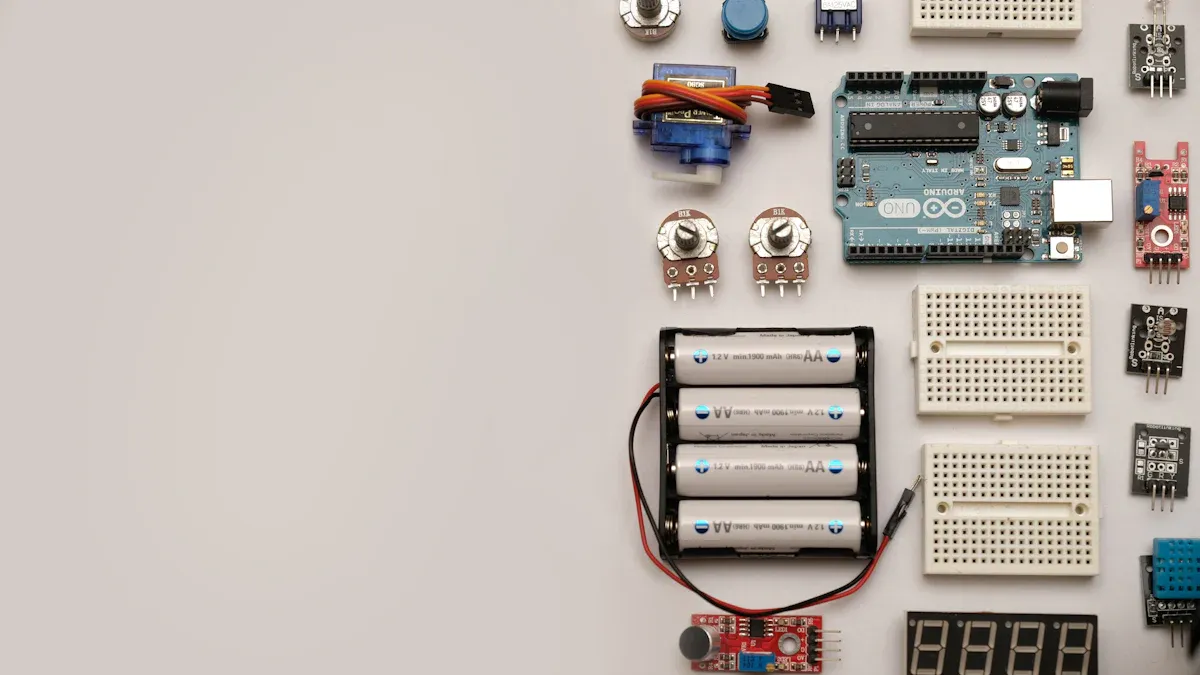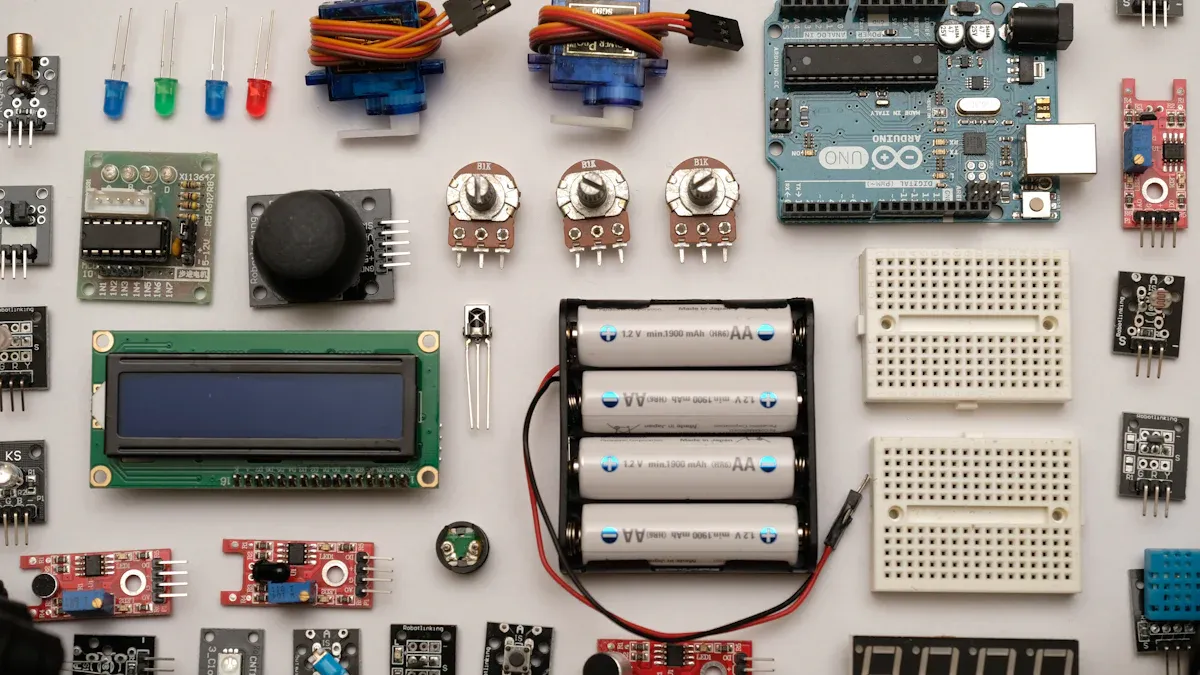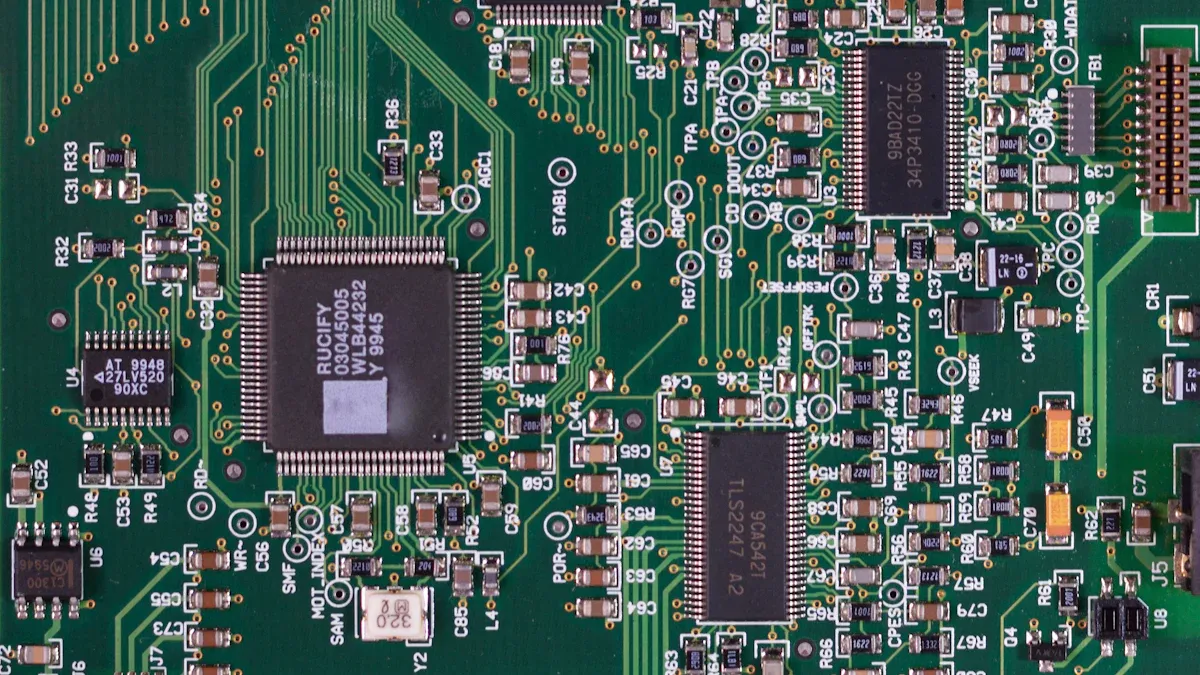LM331AU-S5TR Explained Simply With Key Features

The LM331AU-S5TR works as a general purpose comparator chip. Engineers use it for precision timing and voltage-to-frequency conversion tasks. It operates with a wide supply voltage range from 2.5 volts to 36 volts, and it features low quiescent current for energy efficiency. Devices like sensors and control systems benefit from its open-collector output and surface mount package, which allow flexible designs and reliable performance.
Key Takeaways
The LM331AU-S5TR is a low-power comparator chip that compares two voltages and outputs a signal based on which is higher.
It works with a wide supply voltage range from 2.5 to 36 volts and operates reliably in temperatures from -40°C to 125°C.
The chip uses very little power, making it ideal for battery-powered and portable devices that need long battery life.
Its open-collector output and compatibility with TTL and CMOS logic make it easy to connect with other digital circuits.
The small surface mount package saves space and supports flexible, efficient circuit designs for many applications.
What is LM331AU-S5TR?

Basic Function
The LM331AU-S5TR is a low power, single differential comparator. It compares two input voltages and outputs a signal based on which input is higher. This chip works over a wide supply voltage range from 2.5 volts to 36 volts. It features an open-collector, rail-to-rail output, which means the output can swing very close to the supply rails. The device has a low input offset voltage, typically ±3 millivolts, and a low input bias current, usually around 4 nanoamperes. These features make it suitable for precision tasks. The LM331AU-S5TR also includes internal ESD protection, which helps protect the chip from static electricity damage. The device comes in a small SOT-23-5 surface mount package, making it easy to use in compact circuit designs.
Note: The LM331AU-S5TR operates reliably in temperatures from -40°C to 125°C. This wide temperature range allows it to work in many different environments.
Common Uses
Engineers use the LM331AU-S5TR in many types of electronic circuits. Its main jobs include:
Acting as a threshold detector in control systems.
Serving as a signal detector in infrared receivers.
Working as a timing element in relaxation oscillators.
Converting voltage changes into frequency signals for voltage-to-frequency converters.
Providing fast switching in digital logic circuits.
The chip supports both single and dual supply operation, which makes it ideal for battery-powered devices. Its open-collector output allows users to connect multiple outputs together for logic functions. The LM331AU-S5TR is compatible with TTL and CMOS logic families, so it can connect directly to many types of digital circuits.
Date | Version | Key Updates |
|---|---|---|
2018/12/6 | 1.0 | Updated package information; removed Vos room temperature limit |
2019/6/15 | 1.1 | Updated hysteresis calculation equations |
2019/10/28 | 1.2 | No specific notes provided |
2020/1/1 | 1.3 | Updated LM331AU mark |
This table shows the most recent updates to the LM331AU-S5TR product line. The chip continues to improve with each revision, making it a reliable choice for new designs.
LM331AU-S5TR Features

Technical Specs
The LM331AU-S5TR stands out because of its strong technical specifications. It works with a supply voltage from 2.5 volts up to 36 volts. This wide range lets engineers use it in many different circuits. The chip has a low input offset voltage, usually around ±3 millivolts. This means it can compare signals very accurately. The input bias current is also very low, about 4 nanoamperes. Fast response time helps the chip react quickly to changes in input signals. The open-collector output allows the chip to connect with other logic circuits easily.
The LM331AU-S5TR can operate in temperatures from -40°C to 125°C. This makes it reliable for both indoor and outdoor projects.
Power and Efficiency
Many engineers choose the LM331AU-S5TR for its low power use. It draws very little current when it is not switching, which helps save battery life in portable devices. The table below compares the typical quiescent current of this chip with other common comparator chips:
Comparator Model | Typical Quiescent Current | Notes |
|---|---|---|
LMV331TP-TR | Low power, suitable for battery devices | |
LM339A-SR | 300µA (max) | Higher power consumption |
LM393DR-JSM | 400µA per channel | Significantly higher power consumption |
The LM331AU-S5TR uses a similar amount of power as the LMV331TP-TR. Both chips use much less power than the LM339A-SR or LM393DR-JSM. This makes the LM331AU-S5TR a smart choice for energy-efficient designs.
Output and Package
The LM331AU-S5TR features an open-collector, rail-to-rail output. This type of output lets the chip work with different logic levels and connect to other chips easily. The chip comes in several package options, which makes it flexible for many types of circuit boards. The table below shows the main output and package details:
Feature | Details |
|---|---|
Output Type | Open-Collector, Rail-to-Rail |
Tape & Reel (TR), Cut Tape (CT), Digi-Reel® | |
Package / Case | SC-74A, SOT-753 |
Supplier Device Package | SOT-23-5 |
Mounting Type | Surface Mount |
The small SOT-23-5 package helps engineers save space on their circuit boards. Surface mount design makes it easy to place the chip using modern assembly machines. The LM331AU-S5TR fits well in both small gadgets and larger control systems.
LM331AU-S5TR Advantages
Versatility
The LM331AU-S5TR gives engineers many options for different projects. It works with a wide supply voltage range from 2.5 volts to 36 volts. This means it can fit into many battery-powered devices, from small gadgets to larger systems. The chip uses only 150 microamps of current per channel, no matter the supply voltage. This low power use helps batteries last longer. The input common-mode voltage range includes ground, so the chip can work even at low voltages.
The device has a low input bias current and a low offset voltage. These features help it measure signals accurately and use less energy.
Its outputs work with TTL and CMOS logic, making it easy to connect with other digital parts.
The LM331AU-S5TR also has rail-to-rail input and output. This lets it handle signals that go close to the supply rails, which adds flexibility.
The chip includes ESD protection, so it can handle static electricity in portable electronics.
It works in temperatures from -40°C to 125°C, so it fits both indoor and outdoor uses.
Tip: The LM331AU-S5TR can help designers build efficient and flexible circuits for many battery-powered products.
Reliability
Engineers trust the LM331AU-S5TR for its strong and steady performance. The chip works well in harsh environments because it can handle a wide temperature range, from –40°C to +125°C. It has strong electrostatic discharge (ESD) protection, rated at 4kV for the Human Body Model and 2kV for the Charged Device Model. This protection keeps the chip safe from static shocks.
The inputs have special diodes and resistors that protect against voltage spikes. These features stop damage if the input voltage goes beyond the supply voltage.
The package can handle high temperatures, up to a junction temperature of 150°C. This helps the chip last longer, even under stress.
The device allows for infinite output short-circuit duration if it has proper heat sinking. This means it can survive faults without failing.
Rail-to-rail input and output add to its robust design, letting it handle signals outside the normal range without problems.
Good board layout, like using bypass capacitors and short leads, can make the chip even more reliable in fast circuits.
Note: The LM331AU-S5TR’s design helps it stay reliable in tough conditions, making it a good choice for critical systems.
Comparison and Benefits
Similar Chips
Many comparator chips share features with the LM331AU-S5TR. Engineers often compare it to chips like LM393, LM2903, LM358, MCP602, and TLV3701. These chips perform similar tasks in electronic circuits. The table below shows how LM2903AL1-SR and its equivalents match up:
Feature/Aspect | LM2903AL1-SR Details |
|---|---|
Equivalent Chips | LM393, LM2903, LM358, MCP602, TLV3701 |
Comparator Type | Dual comparator |
Supply Voltage Range | 2V to 36V (single supply), ±1V to ±18V (dual supply) |
Input Offset Voltage | Typically around 2mV |
Output Type | Open-collector output, compatible with TTL and CMOS loads |
Propagation Delay | Approximately 300ns at 5V |
Operating Temperature | -40°C to +125°C |
Applications | Signal conditioning, voltage level detection, waveform shaping, zero-crossing detection |
Package | 8-pin SOIC surface-mount |
The LM331AU-S5TR stands out because it uses less power and fits into smaller packages. LM2903AL1-SR and LM393 offer dual comparators, while LM331AU-S5TR provides a single comparator in a compact SOT-23-5 package. Both types work well in wide temperature ranges and support open-collector outputs.
User Benefits
Engineers choose the LM331AU-S5TR for several reasons. The chip helps save energy in battery-powered devices because it uses very little current. Its small size makes it easy to fit into tight spaces on circuit boards. The wide supply voltage range allows it to work in many different systems, from small gadgets to large control panels.
The chip connects easily with TTL and CMOS logic, so users can build circuits without extra parts.
Fast response time lets the chip react quickly to changes, which improves performance in timing and detection tasks.
The open-collector output supports flexible logic designs, making it simple to combine signals from multiple chips.
Surface mount packaging speeds up assembly and reduces manufacturing costs.
Tip: Engineers can rely on the LM331AU-S5TR for energy-efficient designs and easy integration into modern electronics.
The LM331AU-S5TR offers engineers a reliable solution for precision timing and voltage-to-frequency conversion. Its low propagation delay, rail-to-rail input and output, and robust ESD protection support accurate and stable operation.
Feature / Parameter | Description / Impact on Suitability |
|---|---|
Low Propagation Delay | Enables high-frequency oscillation, critical for precise timing and voltage-to-frequency conversion. |
Low Input Bias Current | In the picoampere range, allows use with high resistance sources, improving accuracy and stability in measurement. |
Rail-to-Rail Input/Output | Inputs can exceed supply rails; outputs swing within 10mV of rails, enabling accurate threshold detection and ground sensing. |
When selecting this chip, engineers should check voltage compatibility, use proper PCB layout, and manage thermal conditions. The LM331AU-S5TR helps create energy-efficient and dependable circuits for many applications.
FAQ
What does the LM331AU-S5TR chip do?
The LM331AU-S5TR compares two voltages and gives an output signal. Engineers use it for timing, voltage-to-frequency conversion, and signal detection in electronic circuits.
Can the LM331AU-S5TR work in cold or hot places?
Yes. The chip works from -40°C to 125°C. It stays reliable in both cold and hot environments. This makes it useful for outdoor and industrial devices.
Is the LM331AU-S5TR good for battery-powered devices?
Yes. The chip uses very little power. Devices with batteries last longer when they use this chip. Engineers often choose it for portable gadgets.
How does the LM331AU-S5TR connect to other chips?
The LM331AU-S5TR has an open-collector output. Engineers can connect it to TTL or CMOS logic circuits. This makes it easy to use in many designs.
See Also
Fundamentals And Uses Of Analog Integrated Circuit Design
A Clear Guide To Low-Dropout Linear Regulator Chips
Key Features And Functions Of IC Audio Signal Processors
How Integrated Battery Monitor ICs Operate And Their Purpose
